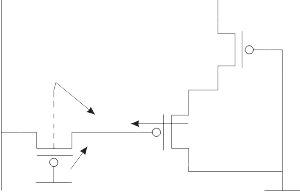Development of 3T eDRAM gain cells for enhancing read margin and data retention
DOI:
https://doi.org/10.3103/S073527271603002XKeywords:
logic compatible eDRAM, data retention, 3T gain cell, enhanced read margin, static power, nanotechnologyAbstract
This paper presents three transistors (3T) based Dynamic Random Access Memory (DRAM) cell in which noise, static power, and data retention voltage (DRV) have been reduced. The spesified parameters in the proposed eDRAM gain cell were improved by connecting the source of storage device to the read word line signal instead of supply voltage. As we all know, power consumption plays a vital role in VLSI design and thus, it is enumerated among the top challenges for the semiconductor chip industries. With the intention to maintain the performance of write operation, we diminish DRV and increase the read margin of eDRAM cell with our designed circuit which is introduced as “A Boosted 3T eDRAM gain cell”. It is a kind of eDRAM cell that utilizes a read word line (RWL) via three PMOS transistors instead of NMOS transistors. PMOS devices are preferred as they have radically less gate leakage current, which confer better results for data retention and thus, boost up the read margin of the cell. Simulation results have been obtained by using Cadence Virtuoso Tool at 45 nm technology for the proposed model. Based on simulation results we can conclude that the parameters of the proposed eDRAM gain cell essentially improved as compared with convertional eDRAM gain cell and the achieved parameters are as follows: static power is 0.767 pW, DRV is 142.009 mV and noise is 8.421 nV/Hz1/2.References
- SZE, S.M. Physics of Semiconductor Devices, 2nd ed. New York: Wiley, 1981.
- MATICK, R.E.; SCHUSTER, S.E. Logic-based eDRAM: Origins and rationale for use. IBM J. Res. Develop., Jan. 2005, v.49, n.1, p.145-165, DOI: http://dx.doi.org/10.1147/rd.491.0145.
- BARTH, J.; REOHR, W.R.; PARRIES, P.; FREDEMAN, G.; GOLZ, J.; SCHUSTER, S.E.; MATICK, RICHARD E.; HUNTER, H.; TANNER, C.C.; HARIG, J.; KIM, H.; KHAN, B.A.; GRIESEMER, J.; HAVRELUK, R.P.; YANAGISAWA, K.; KIRIHATA, T.; IYER, S.S. A 500 MHz random cycle, 1.5 ns latency, SOI embedded DRAM macro featuring a three-transistor micro sense amplifier. IEEE J. Solid-State Circuits, Jan. 2008, v.43, n.1, p.86-95, DOI: http://dx.doi.org/10.1109/JSSC.2007.908006.
- LUK, W.K.; CAI, JIN; DENNARD, R.H.; IMMEDIATO, M.J.; KOSONOCKY, S.V. A 3-transistor DRAM cell with gated diode for enhanced speed and retention time. Proc. of IEEE Symp. on VLSI Circuits, Honolulu, HI : Digest of Technical Papers. IEEE, 2006, p.184-185, DOI: http://dx.doi.org/10.1109/VLSIC.2006.1705371.
- CHUN, KI CHUL; JAIN, P.; LEE, JUNG HWA; KIM, C.H. A sub-0.9V logic-compatible embedded DRAM with boosted 3T gain cell, regulated bit-line write scheme and PVT-tracking read reference bias. Proc. of IEEE Symp. on VLSI Circuits, 16-18 June 2009, Kyoto, Japan. IEEE, 2009, p.134-135, http://ieeexplore.ieee.org/xpl/login.jsp?tp=&arnumber=5205419&url=http%3A%2F%2Fieeexplore.ieee.org%2Fxpls%2Fabs_all.jsp%3Farnumber%3D5205419.
- KIYOO ITOH, B.S. Trends in megabit DRAM circuit design. IEEE J. Solid-State Circuits, Jun. 1990, v.25, n.3, p.778-789, DOI: http://dx.doi.org/10.1109/4.102676.
- AKASHE, SHYAM; SINHA, DEEPAK KUMAR; SHARMA, SANJAY. A low leakage current power 45-nm CMOS SRAM. Indian J. Sci. Technol., 2011, v.4, n.4, p.440-442, DOI: http://dx.doi.org/10.17485/ijst/2011/v4i4/30019.
- SHRIVASTAVA, AKANSHA; KHANDELWAL, SAURABH; AKASHE, SHYAM. Low power analysis in single stage source coupled VCO with AVL technique using nanoscale CMOS technology. Proc. of IEEE Students Conf. on Engineering and Systems, SCES, 12-14 Apr. 2013, Allahabad, India. IEEE, 2013, p.1–6, DOI: http://dx.doi.org/10.1109/SCES.2013.6547488.
- CHANDRAKASAN, A.P.; BRODERSEN, R.W. Low Power Digital CMOS Design. Wiley–IEEE Press, Jan. 1998.
- BUTTS, J.A.; SOHI, G.S. A static power model for architects. Proc. of 33rd Annual IEEE/ACM Int. Symp. on Microarchitecture, MICRO-33, 10-13 Dec. 2000, Monterey, CA. IEEE, 2000, p.191-201, DOI: http://dx.doi.org/10.1109/MICRO.2000.898070.
- SEEVINCK, E.; VAN BEERS, P.J.; ONTROP, H. Current-mode techniques for high-speed VLSI circuits with application to current sense amplifier for CMOS SRAM’s. IEEE J. Solid-State Circuits, Apr. 1991, v.26, n.4, p.525-536, DOI: http://dx.doi.org/10.1109/4.75050.
- SIM, JAE-YOON; YOON, HONGIL; CHUN, KI-CHUL; LEE, HYUN-SEOK; HONG, SANG-PYO; LEE, KYU-CHAN; YOO, JEI-HWAN; SEO, DONG-IL; CHO, SOO-IN. A 1.8-V 128-Mb mobile DRAM with double boosting pump, hybrid current sense amplifier, and dual-referenced adjustment scheme for temperature sensor. IEEE J. Solid-State Circuits, Apr. 2003, v.38, n.4, p.631-640, DOI: http://dx.doi.org/10.1109/JSSC.2003.809514.

Downloads
Published
2016-03-11
Issue
Section
Research Articles

